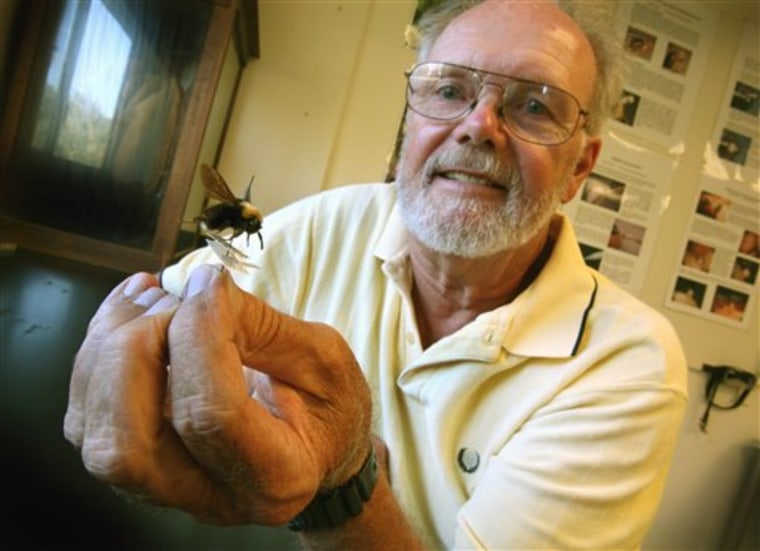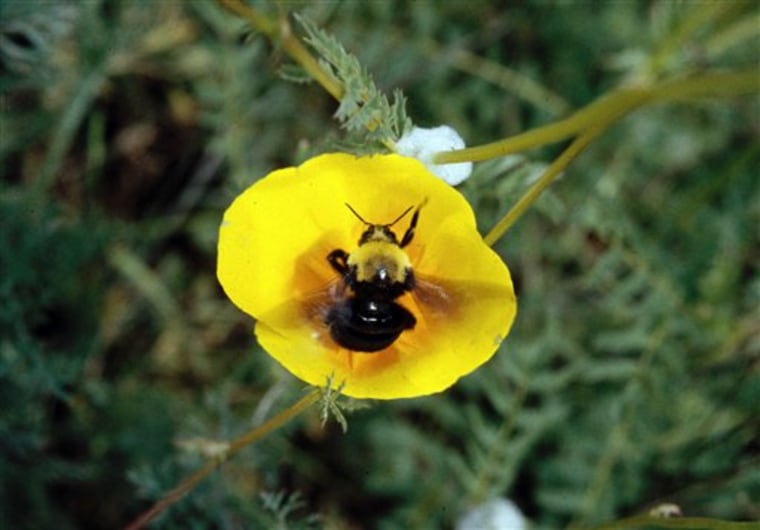Looking high and low, Robbin Thorp can no longer find a species of bumblebee that just five years ago was plentiful in northwestern California and southwestern Oregon.
Thorp, an emeritus professor of entomology from the University of California at Davis, found one solitary worker last year along a remote mountain trail in the Siskiyou Mountains, but hasn't been able to locate any this year.
He fears that the species — Franklin's bumblebee — has gone extinct before anyone could even propose it for the endangered species list. To make matters worse, two other bumblebee species — one on the East coast, one on the West — have gone from common to rare.
Amid the uproar over global warming and mysterious disappearances of honeybee colonies, concern over the plight of the lowly bumblebee has been confined to scientists laboring in obscurity.
But if bumblebees were to disappear, farmers and entomologists warn, the consequences would be huge, especially coming on top of the problems with honeybees, which are active at different times and on different crop species.
Bumblebees are responsible for pollinating an estimated 15 percent of all the crops grown in the U.S., worth $3 billion, particularly those raised in greenhouses. Those include tomatoes, peppers and strawberries.
Demand is growing as honeybees decline. In the wild, birds and bears depend on bumblebees for berries and fruits.
Plenty of threats
There is no smoking gun yet, but a recent National Academy of Sciences report on the status of pollinators around the world blames a combination of habitat lost to housing developments and intensive agriculture, pesticides, pollution and diseases spilling out of greenhouses using commercial bumblebee hives.
"We have been naive," said Neal Williams, assistant professor of biology at Bryn Mawr College in Pennsylvania. "We haven't been diligent the way we need to be."
The threat has bumblebee advocates lobbying Congress to allocate more money for research and to create incentives for farmers to leave uncultivated land for habitat. They also want farmers to grow more flowering plants that native bees feed on.
"We are smart enough to deal with this," said Laurie Adams, executive director of the Pollinator Partnership. "There is hope."
Companies in Europe, Israel and Canada adapted bumblebees to commercial use in the early 1990s, and they are now standard in greenhouses raising tomatoes and peppers.

Demand is growing as supplies of honeybees decline, especially for field crops such as blueberries, cranberries, watermelon, squash, and raspberries, said Holly Burroughs, general manager for production for the U.S. branch of Koppert Biological Systems Inc., a Netherlands company that sells most of the commercial bumblebees in the U.S.
One new customer is Tony Davis of Quail Run Farm in Grants Pass. He has long depended on volunteer bumblebees to fertilize the squash, cucumbers, tomatoes and eggplant he grows outdoors for sale in growers' markets. When he started growing strawberries in greenhouses this year to get a jump on the competition, he bought commercial bumblebee hives to fertilize them.
"Without bumblebees, I would be out of business. I don't think I could hand-pollinate all these plants," he said.
Scientists hoping to pinpoint the cause of the nation's honeybee decline recently identified a previously unknown virus, but stress that parasitic mites, pesticides and poor nutrition all remain suspects.
Bumble vs. honey
Unlike honeybees, which came to North America with the European colonists of the 17th century, bumblebees are natives. They collect pollen and nectar to feed to their young, but make very little honey.
A huge problem facing scientists is how "appallingly little we know about our pollinating resources," said University of Illinois entomology Prof. May Berenbaum, who headed the National Academy of Sciences report.
Scott Black, executive director of the Xerces Society for Invertebrate Conservation in Portland, worries that on top of pesticides and narrowing habitats, disease could be the last straw for many of the bee species.
"It definitely could all come crashing down," he said.
